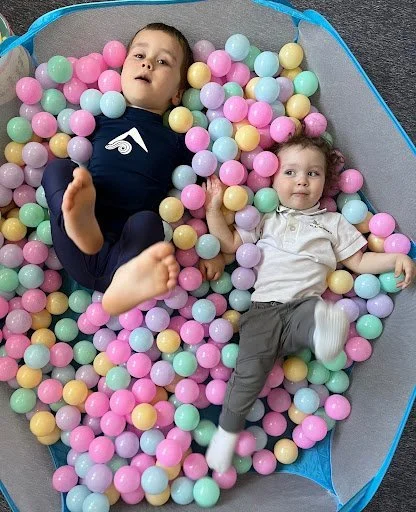Making Sense of Things: Understanding your child’s unique sensory needs
In all my years working with children, I have added many different “tools” to my therapy toolbox. But I think the most impactful one is something that everyone can learn, without needing an advanced degree. I strongly believe that if all parents learn about this idea, they will better understand both themselves and their children.
What is this magic idea that influences every person’s life? Sensory processing!
Sensory processing describes our brain’s ability to organize, prioritize, and apply meaning to the sensory information we receive from the world around us. We’re all familiar with the five main senses: sight, smell, taste, touch, and hearing. In addition to those, our bodies have three other senses:
Proprioception tells us about our body’s position in space
Vestibular sense tells us about how our body is moving in the world
Interoception gives us a report on our body’s internal state.
Our brain is constantly receiving signals about these 8 different senses, and using that information to allow us to interact with our world in meaningful and coordinated ways.
Imagine this: Your significant other brings you a fresh cup of coffee in bed. (Lucky, I know!) Your vision tells you where the mug is. You reach for it, and because you feel that the mug is hot, you make sure to grasp the handle. It weighs more than an empty mug, so your arm adjusts to take the weight. It tastes and smells amazing. In between sips, you look down to read a newspaper, knowing exactly how far down and up your head needs to move to shift your gaze. You hear the birds chirping outside. After a few sips, you feel your belly gurgling… uh oh! Off to the bathroom just in time.
This little scenario is just a very brief snapshot into how your sensory systems are constantly working together to carry out daily tasks. Most of the time, these signals are not even brought to our conscious mind, unless they are particularly salient or warning us of danger.
When the sensory systems do not work in such a coordinated way, this is called Sensory Processing Disorder (SPD). Many children who spent time in the NICU experience SPD, and there are known correlations between SPD and things like prematurity, neurodivergence, and developmental disabilities. Although these factors may increase someone’s likelihood of having SPD, every person has a unique sensory profile, or “default settings” to their various sensory systems.
My favorite way to illustrate SPD is using three different sized cups. Imagine you have in front of you a small medicine cup, a standard coffee mug, and a Starbucks venti cup. If we fill the standard mug with water, what would happen when we pour its contents into the venti cup? It would barely reach the halfway point. Now what about the medicine cup? It would overflow all over the table in no time.
The cups represent your brain’s capacity for a particular sensation, and the water represents the amount of that sensation you are receiving from the environment. For people with “medicine cup” sized sensory thresholds, something like the sound of a blender can be extremely overwhelming, even painful. And for the kid whose movement threshold is venti-sized, it may seem like no amount of swinging will ever be enough to satisfy them. Each person has uniquely sized cups for each sensory system, and those sizes can shift depending on the situation or how they’re feeling in the moment. It’s like a soundboard with 8 different dials that can go up or down throughout the day.
Once we recognize our child’s unique sensory needs, what do we do about it? In therapy, we talk about “sensory regulation” being the ultimate goal. Being “regulated” means that the person’s sensory systems are balanced in such a way that they are feeling calm, in control, and ready to interact with their world. “Regulated” looks different for each individual and is unique to each setting. For example, your sensory needs for focusing in a classroom are very different from your sensory needs when jumping up and down at a concert.
The thing about sensory needs is that they are NEEDS, and not something we can voluntarily change. A child whose sensory needs are not met might appear to be “acting out” or “tantruming,” when really they are feeling out of control and stressed because of their sensory environment. This is why I advocate for every parent to get to know their child’s unique sensory profile. When you understand your child’s sensory needs, you can help them feel safe and ready to engage with their world by adjusting their environment to support them.
If all of this is new to you and you’d like to learn more, this checklist is a helpful resource for both adults and children. Additionally, an occupational therapist trained in sensory processing can perform a full sensory assessment and help your family come up with a “sensory diet” that will help meet your child’s regulation needs.
Find out more:
How early intervention can help support your child’s sensory needs.
Occupational therapist Alesia DiSano explains sensory integration on The NICU Alumni Podcast.
Favorite resources from Lemon City Collective, the therapy group run by Brittany.
Lastly, check out Brittany’s episode on The NICU Alumni Podcast here.


